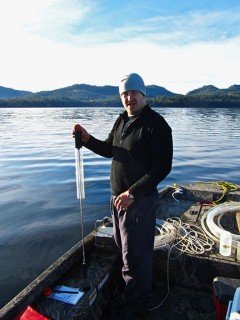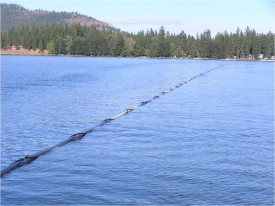The influence of oxygenation on the use of methane-derived carbon in aquatic food webs
by Andrew Wright Child, PhD candidate, Washington State University School for the Environment

Andrew collecting sediment organic matter for stable isotope analysis at Twin Lakes, Washington.
During the summer, Washington lakes commonly stratify, or separate, into layers of different densities. Throughout summer stratification, warmer waters remain near the surface (epilimnion) and colder waters remain in the bottom (hypolimnion). Over time, lakes can accumulate large amounts of organic sediment from both internal lake production and sedimentation from the watershed. As these sediments biodegrade, microorganisms deplete the surrounding dissolved oxygen (DO) supplies in the hypolimnion. These DO supplies are not replenished until waters mix in the autumn when the epilimnion cools to the temperature of the hypolimnion. Hypolimnetic DO depletion favors the release of bound oxidized chemical species (i.e., orthophosphate, iron, manganese, etc.), and increases anaerobic microbial respiration by-products (like ammonia, hydrogen sulfide, methane, and more). Methane is a powerful greenhouse gas, and an estimated 6-16% of natural global atmospheric methane comes from lakes each year.
Hypolimnetic oxygenation is a lake restoration technology used to prevent internal phosphorous recycling and increase fish habitat. With hypolimnetic oxygenation, pure oxygen is injected into the hypolimnion without disrupting stratification; the intent is to restore DO levels where sediment and water meet. DO at the sediment-water interface is important in regulating methane flux, and hypolimnetic oxygenation can lower methane concentrations in the water column.
Midge larvae (Diptera:Chironomidae) growing in lake sediments with an anoxic sediment-water interface are known to get much of their nutrition by consuming bacteria that oxidize methane. Consumption of these methane-oxidizing bacteria (MOB) by larval chironomids has been extensively examined using natural abundance stable isotope analysis, but to our knowledge no work had considered lakes with hypolimnetic oxygenation. Because the ratio of carbon atoms in biologically produced methane is uniquely low, it is fairly easy to detect in the food web with stable isotope analysis. The ratio of carbon atoms in your body mirrors the ratio of your prey, and if you only consume an item that has a distinct isotopic fingerprint (i.e., MOB), it is fairly easy to figure out what you have eaten!
MOB need both DO and methane to complete oxidation. So the greatest MOB consumption in eutrophic lakes normally occurs during autumn turnover when DO-rich waters from the surface mix with methane-rich waters from the anoxic hypolimnion. Since hypolimnetic oxygenation lowers the amount of methane accumulation in the water column, we hypothesized that hypolimnetic oxygenation would limit the amount of methane in the water during autumn turnover and subsequently the MOB that could be consumed by midge larvae. To test the influence of hypolimnetic oxygenation on chironomid use of MOB, we compared stable isotope values in larvae collected from three eastern Washington lakes: Newman Lake (20 years of hypolimnetic oxygenation), North Twin Lake (five years of hypolimnetic oxygenation) and South Twin Lake (unoxygenated).
To our surprise, our results directly contradicted our original hypothesis. Instead of finding lower amounts of MOB influence in lakes with hypolimnetic oxygenation, we found an increase. In fact, we found almost no influence of MOB in larvae from anoxic South Twin Lake. We knew that hypolimnetic oxygenation would lower the amount of methane in the water column, but wondered why the decrease in methane accumulation brought an increase in dietary influence of MOB in chironomids.

Oxygen line floating on the surface of North Twin Lake, Washington before being submersed into the hypolimnion for our study.
We found this was easily explained by the mechanism that was decreasing the methane concentrations. Hypolimnetic oxygenation likely lowers the amount of methane in the water column because it provides the limiting reactant of methane oxidation in anoxic eutrophic lakes—DO. In other words, by increasing DO to the hypolimnion we were in essence allowing the MOB to thrive during the entire summer instead of only during autumn turnover, and South Twin was so anoxic that there was little to no time when oxygen penetrated to the bottom of the lake before the larvae were “hibernating” for the winter and no longer eating. Thus, those lakes with oxygenation had more MOB influence than the lake that was not oxygenated.
Although our results were not what we expected, we were excited and gained several insights. Hypolimnetic oxygenation is a multi-faceted restoration device that affects several levels of biochemistry. We already knew that hypolimnetic oxygenation could decrease lake algal production by slowing internal phosphorous loading, and that it could lower methane emissions. What we additionally learned was that hypolimnetic oxygenation not only decreases greenhouse gas emissions (i.e., methane) but at the same time captures this energy in benthic MOB production. This increase in MOB can now be used (and maybe even “farmed”) by chironomids, which make this relatively low-grade food source into high-quality protein consumed by fish, birds, bats, and spiders when they emerge as adults and take wing each spring.
Additionally, increases in benthic MOB populations can drive the methane cycle to produce more methane, which suggests that hypolimnetic oxygenation may increase microbial breakdown of the organic matter that created the anoxia in the first place. As environmental researchers, we always find it remarkable to see how biological systems adapt to change; examining how lake systems respond to the addition of hypolimnetic oxygenation is no exception. Hypolimnetic oxygenation is fundamentally changing when, where and which organisms can thrive, with cascading trophic effects in the way that energy is processed across their ecosystems.









